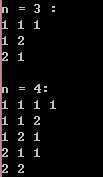标签:style blog http color os io
例:3阶台阶的走法是
{
{ 1, 1, 1, },
{ 1, 2, },
{ 2, 1, },
}
因为每一步只有两个选择1/2阶,那么根据题意可建立一棵二叉树,比如当n=3时:
0 / 1 2 / \ / 1 2 1 / 1
这样(深搜+回溯)一棵树的所有到达叶子节点的路径就是上楼梯的所有方法了
(递归法)C++代码如下:
#include <iostream>
#include <list>
struct Node { int value = 0; Node *left = nullptr; Node *right = nullptr; }; //@param n 总楼梯数 //@param value 步长(1 || 2) //@param cur 当前已走过的总楼梯数 void BuildTree(Node *root, int n, int value, int cur = 0) { root->value = value; cur += value; if (cur == n) return; if (cur + 1 <= n) { root->left = new Node; BuildTree(root->left, n, 1, cur); } if (cur + 2 <= n) { root->right = new Node; BuildTree(root->right, n, 2, cur); } } void PrintAll(Node *root, std::list<int> &vec, int cur = 0) { if (root == nullptr) return; cur += root->value; vec.push_back(root->value); if (root->left == nullptr && root->right == nullptr) { for (int i : vec) { if(i != 0) printf("%d ", i); } printf("\n"); } PrintAll(root->left, vec, cur); PrintAll(root->right, vec, cur); vec.pop_back(); } void DeleteAll(Node *root) { if (root == nullptr) return; DeleteAll(root->left); DeleteAll(root->right); delete root; } void Compute(int n) { Node *root = new Node; std::list<int> st; BuildTree(root, n, 0); PrintAll(root, st); DeleteAll(root); } int main() { std::cout << "n = 3 :" << std::endl; Compute(3); std::cout << std::endl; std::cout << "n = 4:" << std::endl; Compute(4); }

(递归法)lua 代码:
--@param n 总楼梯数 --@param value 步长(1 || 2) --@param cur 当前已走过的总楼梯数 function BuildTree(root, n, value, cur) root.value = value cur = cur + value if cur == n then return end if cur + 1 <= n then root.left = { value = 0, left = nil, right = nil} BuildTree(root.left, n, 1, cur) end if cur + 2 <= n then root.right = { value = 0, left = nil, right = nil} BuildTree(root.right, n, 2, cur) end end
function PrintAllPath(root, stack, cur)
if root == nil then return end
cur = cur + root.value
table.insert(stack, root.value)
if root.left == nil and root.right == nil then
for key, value in pairs(stack) do
if value ~= 0 then
io.write(value,‘ ‘)
end
end
io.write(‘\n‘)
end
PrintAllPath(root.left, stack, cur)
PrintAllPath(root.right, stack, cur)
table.remove(stack)
end
function Compute(n)
stack = {}
root = { value = 0, left = nil, right = nil}
BuildTree(root, n, 0, 0)
--BuildTree(root, n)
PrintAllPath(root, stack, 0)
end
print("n=3:")
Compute(3)
io.write(‘\n‘)
print("n=4:")
Compute(4)
io.write(‘\n‘)
print("n=5:")
Compute(5)

迭代法(C++):
void BuildTree(Node *root, int n) { if (root == nullptr) return; int cur(0); std::stack<Node*> st; std::map<Node*, int> stepMap;//记录当前已走过的楼梯数 Node *p = root; st.push(p); stepMap[p] = 0; while (!st.empty()) { p = st.top(); st.pop(); cur = stepMap[p]; if (cur + 2 <= n) { p->right = new Node; p->right->value = 2; if (cur + 2 < n) { st.push(p->right); stepMap[p->right] = cur + 2; } } if (cur + 1 <= n) { p->left = new Node; p->left->value = 1; if (cur + 1 < n) { st.push(p->left); stepMap[p->left] = cur + 1; } } } }
迭代法(Lua):
function BuildTree(root, n) if root == nil then return end cur = 0 stack = {} stepMap = {} p = root table.insert(stack, p) stepMap[p] = 0 while(#stack ~= 0) do p = stack[1] table.remove(stack, 1) cur = stepMap[p] if cur + 2 <= n then p.right = {value = 2, left = nil, right = nil} if cur + 2 < n then table.insert(stack, p.right) stepMap[p.right] = cur + 2 end end if cur + 1 <= n then p.left = {value = 1, left = nil, right = nil} if cur + 1 < n then table.insert(stack, p.left) stepMap[p.left] = cur + 1 end end end end
标签:style blog http color os io
原文地址:http://www.cnblogs.com/dvwei/p/3848831.html